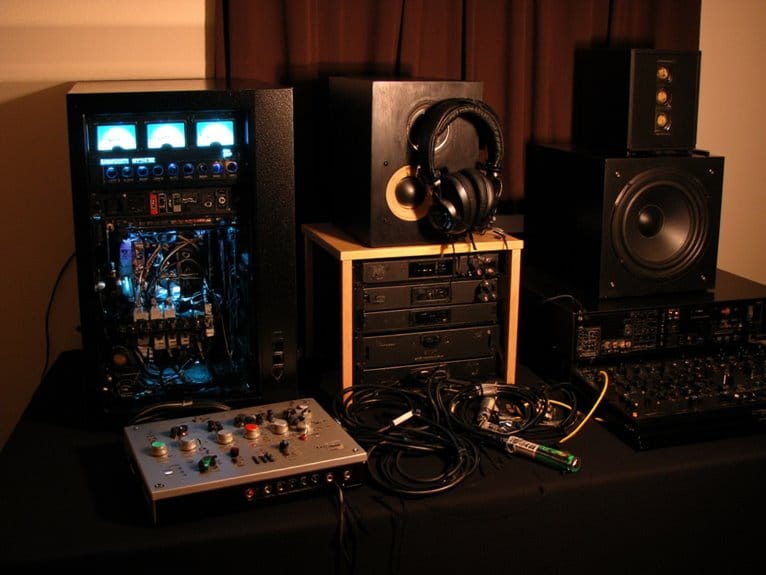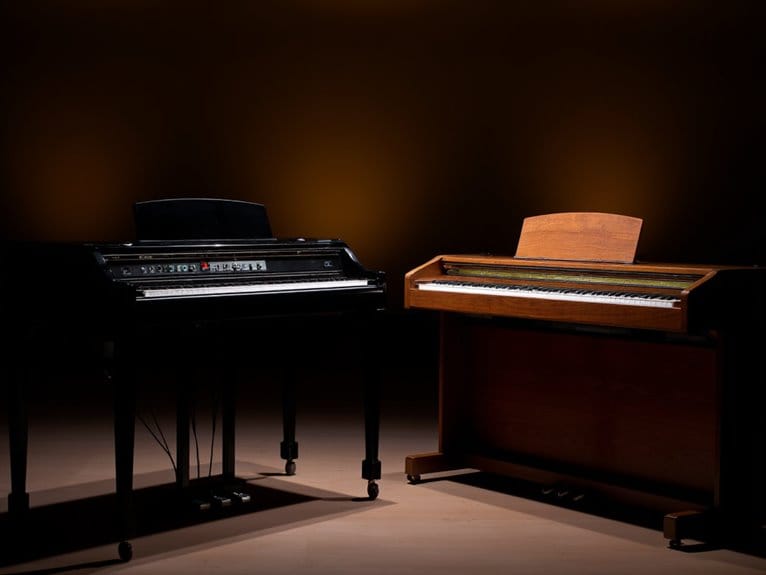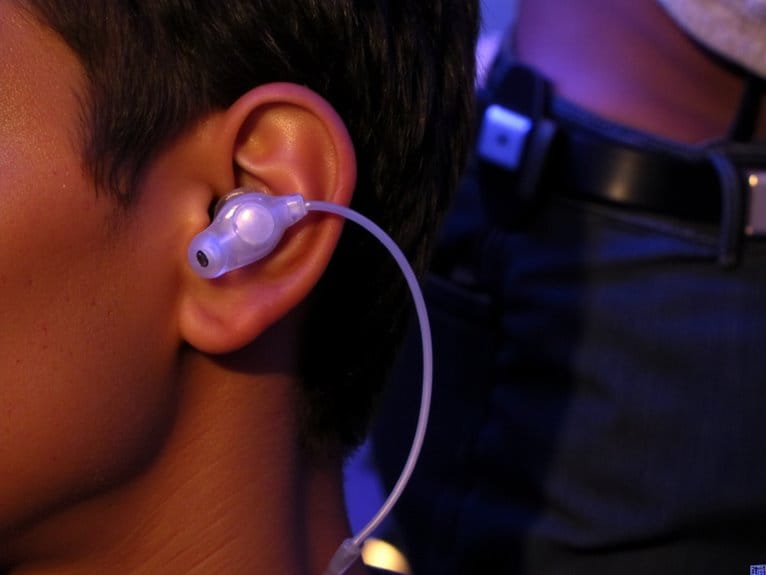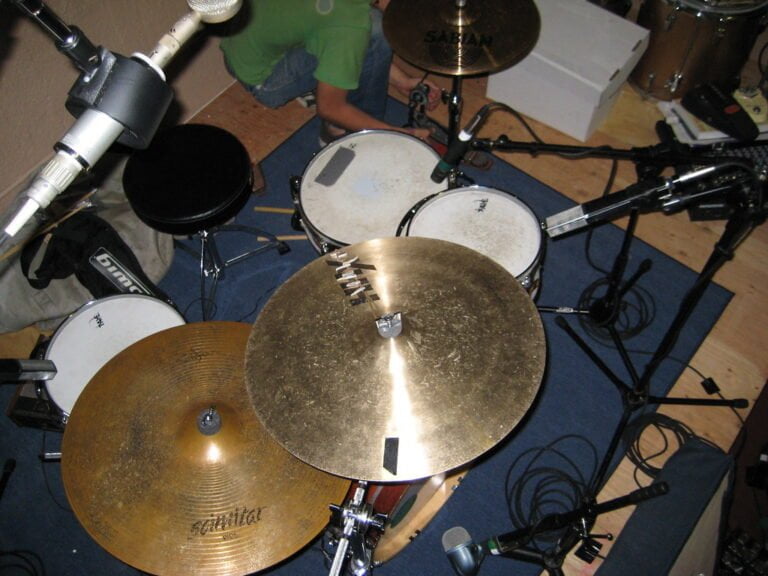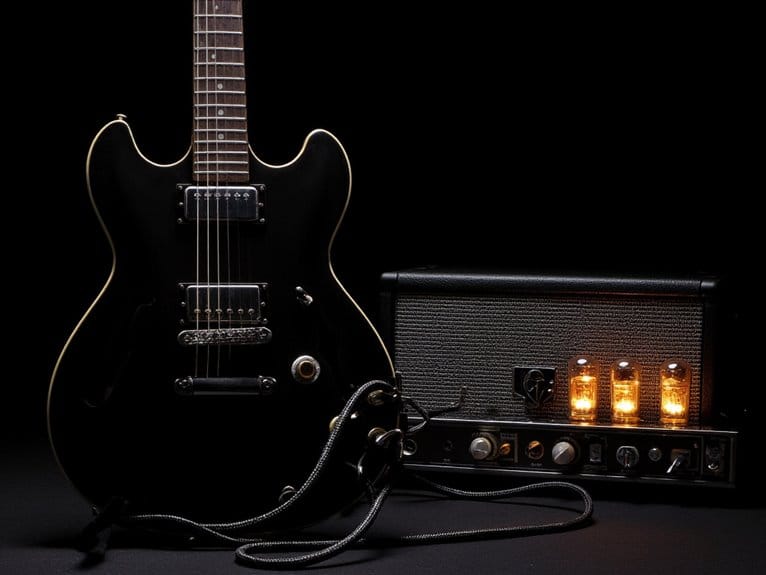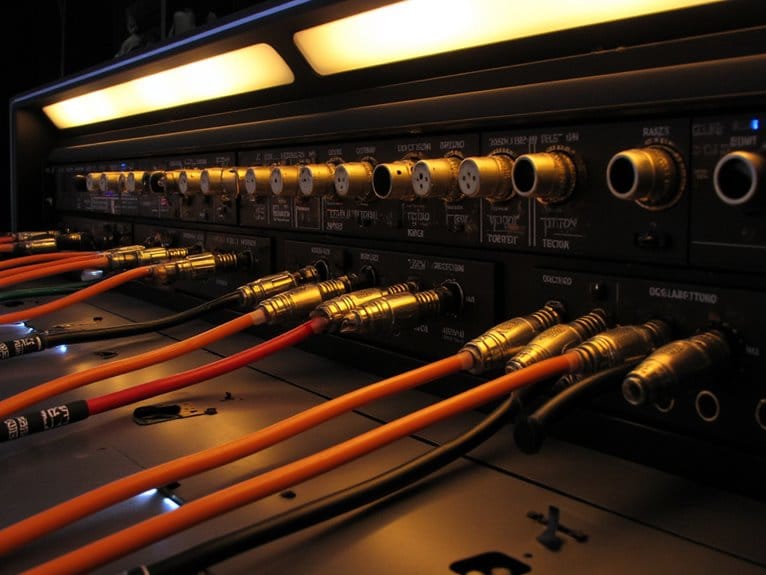Electronic Hi-Hat Systems: Achieving Realistic Feel
You’ll achieve realistic feel in electronic hi-hat systems through dual cymbal sensor technology that tracks separate top and bottom positions, enabling authentic open, closed, and half-open articulations across multiple trigger zones. Modern systems replicate acoustic weight distribution while housing advanced sensors that detect subtle pressure variations and foot control dynamics. High-quality B20 bronze construction, combined with sophisticated sound modules featuring extensive sample libraries, delivers the essential cymbal sparkle and tonal nuances that make electronic hi-hats nearly indistinguishable from their acoustic counterparts, though sensor deterioration and integration challenges remain common limitations that upcoming innovations continue addressing.
We are supported by our audience. When you purchase through links on our site, we may earn an affiliate commission, at no extra cost for you. Learn more.
Notable Insights
- Dual cymbal sensor technology with separate top and bottom sensors enables authentic open, closed, and half-open articulations.
- Balanced trigger system design maintains natural center of gravity and swing motion comparable to acoustic cymbals.
- Advanced sensors detect subtle pressure variations and foot movements for dynamic control and realistic pedal response.
- Multi-zone triggering capabilities distinguish between edge, bow, and bell strikes for comprehensive sound articulation options.
- Real-time sound shaping allows instant adjustments to decay, brightness, and sizzle characteristics during performance.
Dual Cymbal Sensor Technology and Multi-Zone Triggering
The revolution in electronic hi-hat technology begins with dual cymbal sensor systems, which I’ve found to be the most significant advancement in replicating the nuanced behavior of acoustic hi-hats.
When you’re working with dual sensor integration, you’ll notice how separate top and bottom sensors continuously track cymbal position, enabling those vital open, closed, and half-open articulations that make playing feel natural.
What really impressed me, though, is how multi zone dynamics transform your playing experience by dividing each cymbal into distinct trigger areas—edge, bow, and bell zones that respond independently.
This combination allows you to access splash sounds, chick effects, and traditional strikes all from precise strike locations, while the dual sensors simultaneously detect your foot pedal position for seamless changes. The high-quality B20 Bronze construction ensures these sensors maintain their precision and responsiveness over extended use.
Professional models typically feature 12-inch cymbals that provide an optimal balance between responsive triggering area and compact electronic kit integration.
Advanced trigger systems incorporate latency-free triggering technology that eliminates the delay between strike and sound production, ensuring your playing dynamics translate immediately to the electronic module.
Physical Design Elements That Mimic Acoustic Response
When you’re evaluating electronic hi-hats, you’ll quickly discover that manufacturers obsess over matching the exact weight and dimensions of acoustic cymbals, because even a few ounces difference can throw off your muscle memory and playing technique.
The balanced trigger system design becomes essential here, as engineers must strategically position sensors and electronics without disrupting the natural center of gravity that your foot and stick work have adapted to over years of playing.
I’ve found that the best electronic hi-hats actually feel heavier than you’d expect, since they’re compensating for the absence of traditional cymbal mass while housing sophisticated circuitry, pressure sensors, and mechanical components that maintain authentic pedal response. Just as shell material greatly affects tone quality in acoustic drums, the construction materials in electronic hi-hats influence both the tactile response and durability of the system. The advanced sensors in these systems detect subtle variations in pressure and position, enabling the nuanced dynamic control that separates professional-grade equipment from basic models.
Weight and Size Matching
While most drummers wouldn’t think twice about the weight of their acoustic hi-hats until they’re hauling them to a gig, I’ve discovered that replicating this physical heft proves vital for electronic systems that truly feel authentic under your sticks and feet.
Premium manufacturers achieve proper weight dynamics through full-size 14-inch cymbals that match acoustic proportions, while wood shell construction adds significant mass that influences overall drumhead response.
Size consistency becomes particularly important when you’re switching between acoustic and electronic setups, as muscle memory relies on familiar dimensions and weight distribution.
Thicker cymbal designs approximate natural swinging motion, and calibrated pedal assemblies include adjustable weights that replicate the substantial feel of traditional hi-hat stands, ensuring seamless shifts between different kit configurations.
Quality electronic hi-hat systems also incorporate frequency response characteristics that capture the full range of high-frequency details from 5,000 Hz to 20,000 Hz, ensuring the authentic crisp sound that matches the physical feel.
Balanced Trigger System Design
Beyond achieving proper physical proportions, electronic hi-hat systems must solve the complex challenge of translating every subtle stick movement into accurate digital signals, which requires sophisticated trigger networks that I’ve found separate truly professional units from basic consumer models.
The mechanical balance becomes essential here, as manufacturers must carefully calibrate weights, floating bells, and mounting mechanisms to prevent the unnatural tilt that plagues cheaper rubber cymbals.
You’ll notice that premium systems incorporate precisely engineered suspension points that allow natural swing patterns while maintaining trigger sensitivity across the entire surface.
This dynamic response system guarantees your playing technique translates accurately, whether you’re executing gentle ghost notes or aggressive accents, creating that satisfying rebound feel that keeps you engaged during extended practice sessions.
Sound Reproduction Capabilities and Tonal Nuances
As someone who’s spent countless hours behind both acoustic and electronic kits, I can tell you that modern electronic hi-hat systems have reached an impressive level of sonic authenticity that would’ve been unimaginable just a decade ago.
The sound fidelity you’ll experience comes from advanced drum modules featuring extensive sample libraries that capture every nuance, from subtle attack characteristics to natural decay patterns.
What really sets these systems apart is their tonal dynamics – the way they respond to your playing technique with continuous triggering zones that deliver open, closed, half-open, and splash articulations seamlessly.
High-frequency reproduction above 13kHz guarantees you get that essential cymbal sparkle, while MIDI compatibility opens up virtually unlimited sound libraries for any genre.
Performance Versatility and Customization Options
When you’re exploring electronic hi-hat systems, you’ll discover that sound library expansion transforms your kit into a versatile instrument capable of switching between vintage jazz cymbals, modern rock sounds, and experimental electronic textures with just a few button presses.
I’ve found that the real magic happens when you can shape these sounds in real-time during performance, adjusting everything from cymbal decay and brightness to the subtle sizzle characteristics that define your personal groove.
Your ability to customize these parameters on the fly, whether you’re laying down tracks in the studio or adapting to different songs during a live set, fundamentally gives you access to an entire cymbal collection without the physical storage challenges or budget constraints.
Just as drummers need precise control over their acoustic instruments, having the right hardware components with proper gear ratios ensures that your electronic hi-hat pedal responds accurately to subtle foot movements and maintains consistent performance throughout extended playing sessions.
Sound Library Expansion
Expanding beyond factory presets, modern electronic hi-hat systems offer extensive sound library capabilities that transform these instruments from basic practice tools into professional-grade performance machines.
Today’s sound libraries deliver remarkable sample diversity, featuring hundreds of multi-channel recordings captured with premium studio microphones, providing the realistic detail you’d expect from acoustic kits. These expansions include esoteric vintage sounds, multiple articulations like open, closed, and bell hits, plus variations from different stick types including felt mallets and brushes.
Genre-specific packs cater to jazz, funk, or electronic styles, while engine-based synthesis approaches let you manipulate parameters in real-time rather than relying solely on samples, offering greater customization potential for crafting unique timbres.
Real-Time Sound Shaping
While sound libraries provide the raw materials for electronic hi-hat performance, it’s the real-time sound shaping capabilities that truly separate professional systems from basic practice pads, giving you unprecedented control over every nuance of your hi-hat’s voice as you play.
Professional electronic hi-hats excel through sophisticated real time modulation systems that respond instantly to your performance dynamics. You’ll find manual and CV-controlled parameters for decay, tone, and tuning, while dynamic response mechanisms translate foot pressure into authentic open, closed, and partially-open variations.
| Control Type | Real-Time Function |
|---|---|
| Envelope Shaping | Attack, decay, sustain adjustment |
| Pitch Modulation | Random variation, velocity response |
| Spatial Effects | Reverb, stereo positioning |
| Pressure Sensing | Continuous open/closed gradation |
| Multi-Zone Detection | Edge, bow, bell triggering |
These transient shaping tools eliminate post-processing needs while creating evolving textures. Similar to vocal microphones that excel at capturing different instruments, many electronic hi-hat systems offer dual use capabilities for recording acoustic drums alongside their electronic sounds.
Common Limitations in Current Electronic Hi-Hat Models
Despite significant advances in electronic drum technology over the past decade, current electronic hi-hat systems still face several persistent challenges that can frustrate both amateur and professional drummers.
You’ll likely encounter sensor deterioration over time, as piezo sensors commonly detach or lose sensitivity, creating inconsistent trigger responses that diminish your playing experience.
The tactile feedback remains strikingly different from acoustic hi-hats, since stationary controllers can’t replicate the physical cymbal movement and natural rebound you’re accustomed to feeling.
I’ve observed that many systems struggle with dynamic sensing limitations, offering only basic open/closed detection rather than the nuanced intermediate positions essential for expressive playing.
Additionally, you might face integration headaches when connecting to popular DAWs, requiring manual MIDI mapping configurations that complicate your workflow unnecessarily.
Market Innovations and Leading Manufacturer Developments
Fortunately, manufacturers haven’t been sitting idle while these limitations persist, and I’ve witnessed some genuinely impressive developments emerge from leading companies over the past two years that directly address many of these frustrations.
Roland’s 2022 product launches included updated V-Drums models like the TD-17 and TD-27, featuring significant hardware upgrades and enhanced sound modules that deliver more authentic responses.
The HiHatPro 2025 represents a particularly remarkable advancement, incorporating complex movement tracking and multi-level sensitivity that responds to both foot pressure and stick dynamics with remarkable precision.
Market trends show the electronic drum sector reaching $1.6 billion in 2023, with projected growth to $3.8 billion by 2032, driving continuous innovation in expressive versatility and realistic tactile feedback systems.
These advances complement improvements in audio capture technology, with many manufacturers now incorporating dynamic microphones specifically engineered for electronic drum applications to enhance the overall acoustic experience.
Budget-friendly options are also making significant strides, with dual-zone mesh pads becoming standard features that enhance dynamic response and provide more realistic playing experiences across price points.
Hybrid Solutions Combining Electronic and Acoustic Elements
As hybrid drumming solutions continue bridging the gap between acoustic and electronic worlds, I’ve found that dual-cymbal electronic hi-hat controllers represent one of the most compelling innovations for drummers who aren’t ready to abandon their acoustic setups entirely.
These systems excel at hybrid integration, seamlessly mounting on standard hi-hat stands while providing authentic tactile feedback that preserves your acoustic playing technique.
What impresses me most is how these controllers handle acoustic enhancement through embedded triggers that respond to multiple playing zones—bell, bow, and edge—just like traditional cymbals.
The continuous foot control replicates toe pressure dynamics I’m accustomed to, while MIDI compatibility opens extensive sound libraries ranging from vintage samples to synthetic elements.
You’ll maintain familiar stick response while gaining access to creative possibilities that pure acoustic setups simply can’t match.
When selecting hardware for these hybrid setups, ensuring your hi-hat stand includes memory locks helps maintain consistent positioning between acoustic and electronic configurations.
Frequently Asked Questions
Can Electronic Hi-Hats Work With Any Drum Module or Software?
You’ll find most electronic hi-hats work with various drum modules through standard TRS connections, but compatibility issues can arise with proprietary systems like Yamaha. Software integration’s generally excellent since they function as MIDI controllers universally.
How Do Electronic Hi-Hats Perform in Live Concert Environments?
You’ll find electronic hi-hats excel in live performance environments by delivering consistent sound quality regardless of venue acoustics. They’re easier to control volume-wise, reduce stage clutter, and eliminate microphone bleed issues that plague acoustic setups.
Are Electronic Hi-Hats Suitable for Beginner Drummers Learning Technique?
You’ll find electronic hi-hats excellent for learning techniques as they offer adjustable settings, silent practice capabilities, and consistent feedback. Beginner experiences benefit from customizable tension, headphone compatibility, and reduced setup complexity compared to acoustic alternatives.
On a final note
You’ll find that today’s electronic hi-hat systems have come remarkably close to replicating acoustic feel, though they’re not quite perfect yet. The combination of dual sensors, realistic pedal mechanics, and advanced sound engines creates an experience that’s convincing enough for most playing situations. While purists might still notice subtle differences, the gap continues to narrow as manufacturers refine their approaches and hybrid solutions emerge.


